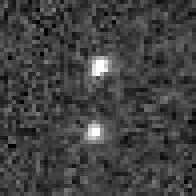 Hubble Space Telescope image of Teharonhiawako and its companion Sawiskera, taken in 2010 | |
| Discovery | |
|---|---|
| Discovered by | Deep Ecliptic Survey |
| Discovery date | 20 August 2001 |
| Designations | |
| (88611) Teharonhiawako | |
| Pronunciation | Mohawk: [d̥ɛhaɺũhjáːɰaɡo] |
| 2001 QT297 | |
| TNO · cubewano[1] cold[2] | |
| Orbital characteristics [3] | |
| Epoch 13 January 2016 (JD 2457400.5) | |
| Uncertainty parameter 3 | |
| Observation arc | 4463 days (12.22 yr) |
| Aphelion | 45.235 AU (6.7671 Tm) |
| Perihelion | 42.454 AU (6.3510 Tm) |
| 43.845 AU (6.5591 Tm) | |
| Eccentricity | 0.031712 |
| 290.32 yr (106041 d) | |
| 158.44° | |
| 0.0033949°/day | |
| Inclination | 2.5834° |
| 304.78° | |
| 236.43° | |
| Known satellites | Sawiskera [zaɰískɛɺa] |
| Physical characteristics | |
| 220+41 −44 km (combined) 178+33 −36 km (primary) 129+24 −26 km (secondary)[4] | |
| Mass | 2.445×1018 kg[5] |
Mean density | 1.15+0.87 −0.91 g/cm3[4] |
| 4.7526±0.0007 h[6] | |
| 0.145+0.086 −0.045[4] | |
| 6.00±0.13[6] 5.8[3] | |
88611 Teharonhiawako (provisional designation 2001 QT197) is a trans-Neptunian object and a member of the cold classical Kuiper belt, measuring about 220 km in diameter. It is a binary object, with a large companion named Sawiskera (formally designated (88611) Teharonhiawako I Sawiskera), which at 126 km in diameter is about two-thirds the size of its primary.[7] The two components together are known as the Teharonhiawako–Sawiskera binary system.
- ^ Cite error: The named reference
Buiewas invoked but never defined (see the help page). - ^ Cite error: The named reference
Brown2013was invoked but never defined (see the help page). - ^ a b Cite error: The named reference
jpldatawas invoked but never defined (see the help page). - ^ a b c Cite error: The named reference
TNOsCool-10was invoked but never defined (see the help page). - ^ Cite error: The named reference
Grundy2011was invoked but never defined (see the help page). - ^ a b Cite error: The named reference
TNOsCool-6was invoked but never defined (see the help page). - ^ Cite error: The named reference
Teharonhiawakowas invoked but never defined (see the help page).